It started with a single shiver. In the 90 degree temperatures of Bodh Gaya, India, I suddenly felt chilled. I pulled my sweatshirt jacket close and snuggled into it. A few moments later, my whole body was wracked by a second shiver. My teeth began to chatter and my skin grew cold and clammy. First my stomach clutched. Then the diarrhea started.
I had come to Bodh Gaya for two reasons. I’d previously traveled to the birthplace of Gautama Buddha in Lumbini, Nepal, and to Sarnath, India, where he first taught the Dharma to his small cadre of followers. But the most important pilgrimage site for any Buddhist is the Bodhi Tree in Bodh Gaya, beneath which Buddha attained enlightenment. After meditating beneath the Bodhi Tree, I planned to attend a ten-day Vipassana Meditation Retreat. But that was not to be.
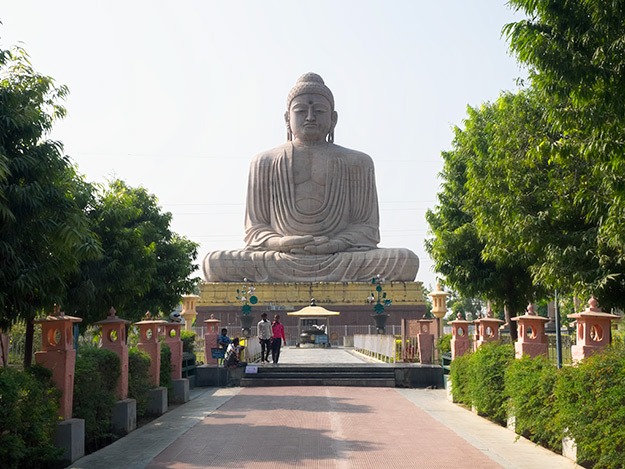
For the next six days, I made a mad dash to the toilet every 20 minutes. Dressed in three layers of clothing, I climbed into bed and piled on every blanket I could find. And still I shivered uncontrollably while cold sweat poured off me. A jackhammer pounded behind my eyes, until I wished my head would split open, and stomach cramps had me curled up in the fetal position. Itchy red bumps appeared all over my torso and back. Even without a thermometer, I knew I was burning up with fever.
On day four, I woke up and couldn’t open my eyes. A crusty film glued my eyelashes together. I rubbed away what I could and was finally was able to pry open my eyelids, but everything was foggy. Blinking did nothing to bring things into focus, so I struggled to the bathroom and looked in the mirror. Both my eyeballs were bright pink. I had developed conjunctivitis.
By this time, I hadn’t eaten a bite of food for more than three days and the hotel staff was becoming concerned. I had declined their repeated offers to take me to a doctor, but not because I didn’t want to get treatment. Two days prior to my arrival in Bodh Gaya, the Prime Minister of India, Narendra Modi, had announced that the 500 and 1,000 Rupee bills would be demonetized, effective immediately.

The move was ostensibly directed at “black money.” In addition to rampant counterfeiting of the currency, a huge percentage of money earned by businesses in India is never reported or deposited in a bank. The running joke is that every Indian keeps his money under the mattress. Of course, no taxes are paid on this unreported income. Some months earlier, Modi had declared a general amnesty period and encouraged tax evaders to disclose unreported income. They would be required to pay the appropriate taxes, but would face no further penalties or criminal prosecution. The effort failed miserably.
One moment, the 6,000 Rupees in my wallet were worth about $90. The next moment they were worthless. Holders of Indian currency were given 50 days to exchange their old notes. Those with bank accounts could deposit unlimited amounts, but exchanges were limited to 2,500 Rupees per day for Indian nationals and 4,000 Rupees per day for tourists. Limits were imposed for good reason. The demonetization order affected more than 85% of the currency in circulation in the country. Only the 100 Rupee bill, worth about $1.40 USD, was retained as legitimate currency. There simply were not enough 100 Rupee bills in circulation to meet demand.
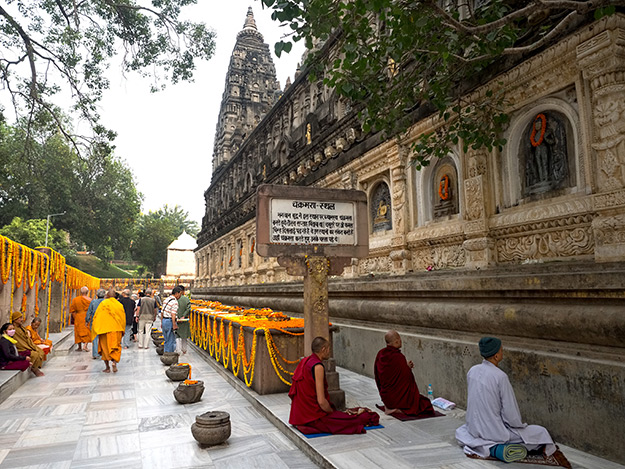
The government planned to replace the demonetized notes with newly designed 1,000 and 2,500 Rupee notes, but they had not yet actually printed any of the new money. Even worse, the new bills were a different size than the old ones, so every single ATM machine in the country had to be retrofitted before they would function properly.
None of this was public knowledge until the moment Modi announced it. Not even the banks were given a heads up. Complete chaos ensued. I spent the better part of the next day standing in line at a branch of the State Bank of India in Varanasi to exchange my bills. I elbowed my way, inch by painful inch, up to the front counter, only to be told I had been standing in the wrong line. With plans to travel to Bodh Gaya the following morning, I had no choice but to step to the rear and begin all over again. The 4,000 Rupees I managed to exchange paid for my accommodations in Varanasi, a train ticket to Bodh Gaya, and a few meals. There was no money left over for a doctor or medicine.
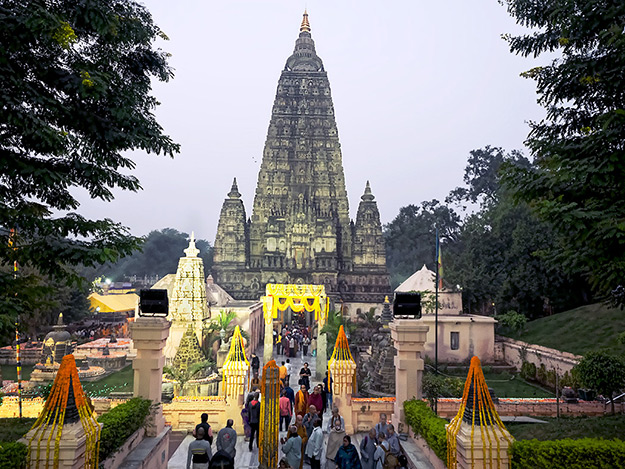
Fortunately, the hotel manager intervened and I finally admitted my problem. “Why didn’t you say so!” he exclaimed. He kindly gave me 1,000 Rupees and charged the amount to my room, which could be paid by credit card upon checkout. Then he made an appointment with a doctor and bundled me into the hotel car.
I had assumed my condition was the result of food poisoning, but the doctor said my symptoms were too severe. He suspected I had contracted a mosquito-borne viral infection, most likely Dengue fever or Chickungunya, both of which are at epidemic proportions in India. Alarmed by my deteriorated condition, he recommended hospitalization. There are many state-of-the-art hospitals in India’s larger cities, but Bodh Gaya is a dusty, polluted backwater. I adamantly refused.
He then suggested an IV to remedy my severe hydration. The doctor’s office was in a dilapidated storefront with an open entrance to the street. During my brief wait, I’d watched an assistant lean babies over his knee, pull down their pants, and administer shots in their bare buttocks – while everyone in the waiting room and the street looked on. Again I shook my head. No one was coming anywhere near me with a needle. The doctor just nodded and began writing prescriptions. An antibiotic, a pill for stomach pain, packets of rehydration salts, and boxes of rehydration liquids.
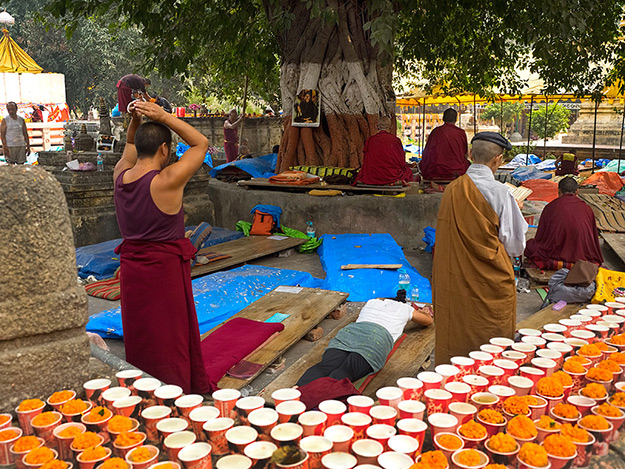
Two days later, new currency was finally available and ATM’s were once again working. The medicine had worked miracles, so I decided to attempt a bank run. The SBI branch in Bodh Gaya was even more chaotic than the one in Varanasi. Hundreds of people massed at the entrance, pushing and shoving to get in. Once inside the ATM booth I breathed easier, but my relief was short-lived. The machines were only giving out the new 2,500 Rupee notes. Though legal tender, they were useless. No cafe, rickshaw, or grocery store had enough 100 Rupee notes to make change for the new larger bills.
Disgustedly, I turned to leave, but the surging crowd had blocked the door to the ATM room. I pushed and pleaded and finally managed to squeeze through, only to be pressed back up against the lobby wall by the now angry crowd. People began to flail and fall to the floor. Realizing I had only moments before a full-blown riot erupted, I hugged the wall and stepped over the customers on the floor. By the time I reached the entrance, rifle-toting army officers were running toward the bank. I yelled for help and one of the soldiers pulled me out by my arm.
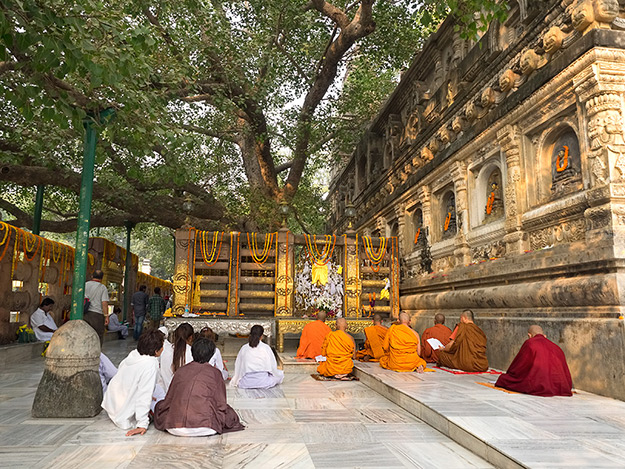
Back in my room, I climbed back into bed and considered my options. I would eat all my meals at the hotel and pay the final bill by credit card. But I absolutely would not leave Bodh Gaya without meditating beneath the Bodhi Tree. Thankfully, entrance to the site was free and I had enough Rupees left to pay the modest fee for taking photos inside the grounds.
Early the next morning I set out for the Mahabodhi Temple. Each step was pure agony. Blaring car horns and the ding-ding-ding of rickshaw bells sent me skittering to the side of the road every few seconds. Motorcycles roared by, kicking up clouds of choking dust. Roadside vendors pleaded with me to look at their wares. I picked through trash and cow shit strewn across the road and focused on placing one foot in front of the other.
Exhausted and stressed, I finally reached the complex and stepped into an alternate universe. Stairs descended to a lush, sunken garden dotted with shrines. At its center stood a massive stone pyramid covered with intricate carvings. Everywhere, pilgrims were pursuing the Tibetan tantric practice of performing 100,000 prostrations. The clacking from their wooden hand protectors mingled with the soothing chants of monks. An intense feeling peace washed over me as I made my way toward the Bodhi Tree at the rear of the temple. My hands began to vibrate and the air became denser with every step. As the tree came into full view, I walked through a curtain of pure energy and sank down beneath its ample canopy to meditate.
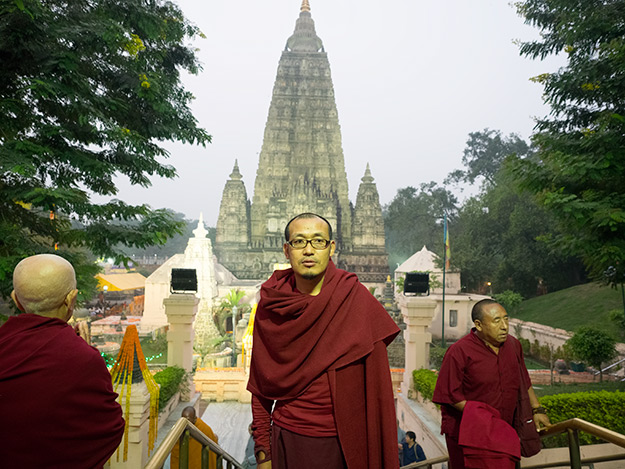
I have no idea how much time passed, but when I opened my eyes a red-robed monk was sitting next to me. He turned and smiled. “Where are you from?” he asked. For the next three hours, we alternated between meditating and discussing Buddhist doctrine. I learned that Pema is from Bhutan and that his main interest is in meditation. He patiently answered my questions and offered to meet me the following day, and then the next as well.
On the afternoon we said our goodbyes, Pema explained that prayers and meditations performed at Mahabodhi Temple are exponentially more powerful than any place else on earth. Though it’s highly unlikely that I will attain Buddhahood in this lifetime, it seems I am firmly on the path. And none of it would have been possible had I not been bitten by that pesky mosquito. I have always believed that everything happens for a reason, but after my pilgrimage to Bodh Gaya I am more convinced than ever before.
Author’s note: I would be remiss not extend my heartfelt thanks to the wonderful employees and management of Hotel Sujata in Bodh Gaya, who took care of me when I was so desperately ill.

Wonderful & very informative article. I think these tips and advice are much helpful. Great Sharing, Thank you for such detailed description of the destination. All the pictures are gorgeous. Excellent Explanation.
Wow, the demonetization period was a tough time for every Indian, I couldn’t even imagine your ordeal, Bodh Gaya is a real nice and peaceful place. Thank you for sharing your experience.
It’s not something I would like to repeat Parvinder, but it did provide me with a good story to tell.
Thank you sharing for your experience. I have visited this temple and the environment is so peaceful here. I loved the culture of Buddhism, so i have visited Bhutan to know about it. Visiting monasteries gives me inner peace.
Hi Alina: Bhutan is definitely on my wish list. I’ve heard so many good things about it. Thanks so much for your comment.
How about living in five-star hotel in the nearest city and then travelling to Bodh Gaya(or any other place) by Tourist Taxi who will also bring you back the same day.
Hi Ravi: If I’d done that, I would have missed out on the wonderful experience I had in Bodh Gaya. It was worth being sick!
what is youradvice for a 70 years old first timer in India
Hi Michel: Wow, that’s a big question, and very hard to answer because I know nothing about your travel style or experience. If you’re heading to India, though, I have to assume you have some travel experience. India is a place you have to be mentally prepared for. Horrible sanitation, stinking heaps of trash, cows wandering everywhere, massive crowds, intense touts constantly in your face. Dirt, dust, noise. So I have a few suggestions. First, other than being mentally prepared, I strongly suggest you splurge a little on an upscale hotel. Despite third-world conditions, the Indians really know how to do luxury accommodations. You need a place like this to retreat to after a day of battling the above. Second, pick a hotel that provides airport pickup. They will have a driver waiting for you outside the luggage area, holding a sign with your name. Trying to use public transportation in India is not something for the faint-hearted or inexperienced. especially when you’ve just spent 24-hours in the air and are dead tired. Once you’re there, the hotels can help you arrange onward transportation. Third, don’t eat any fruit or vegetable that can’t be peeled. If you eat at street stalls (I do), make sure you pick places where the food is being made to order rather than being served from piles of pre-cooked food. Choose only places with long lines, as the locals know which vendors serve safe food. If you’re a vegetarian, that’s a plus but if not, you might consider avoiding meat while in India. Also, sauces can be iffy at street stalls. Be prepared to negotiate for everything. Not bargaining will alert folks that you are a novice in India, and they will try to take advantage of that. If you buy bottles of water on the street, make sure the seal on the cap is not broken. Street vendors sometimes refill bottles and resell, and the water in them is not safe. Those are the big things that come to mind. You will either love it or hate it – there is no in-between in India. I hope, like me, you love it!
Wow! lovely read. You’ve penned down your experiences so amazingly. Brilliant captures.
Thanks so much Lucas. Glad you enjoyed it.
You have some really interesting blog posts on here! Glad I found it! I’m following you…Check out my blog if you get a chance!
Thanks so much Tarin.
Awesome experience!! I had 2 time in Bodh Gaya.. its very hot weather.. but when you reached and feel the place like best experience of life.
Hi Manish. It was definitely life-changing for me!
So sad to learned that you were seriously ill in Bodh Gaya.But the story you told is very comprehensive, interesting and amusing in a way.
Thanks Prasit. I survived, and came out of the experience with greater spiritual understanding and connection. Everything happened as it was supposed to, for sure.